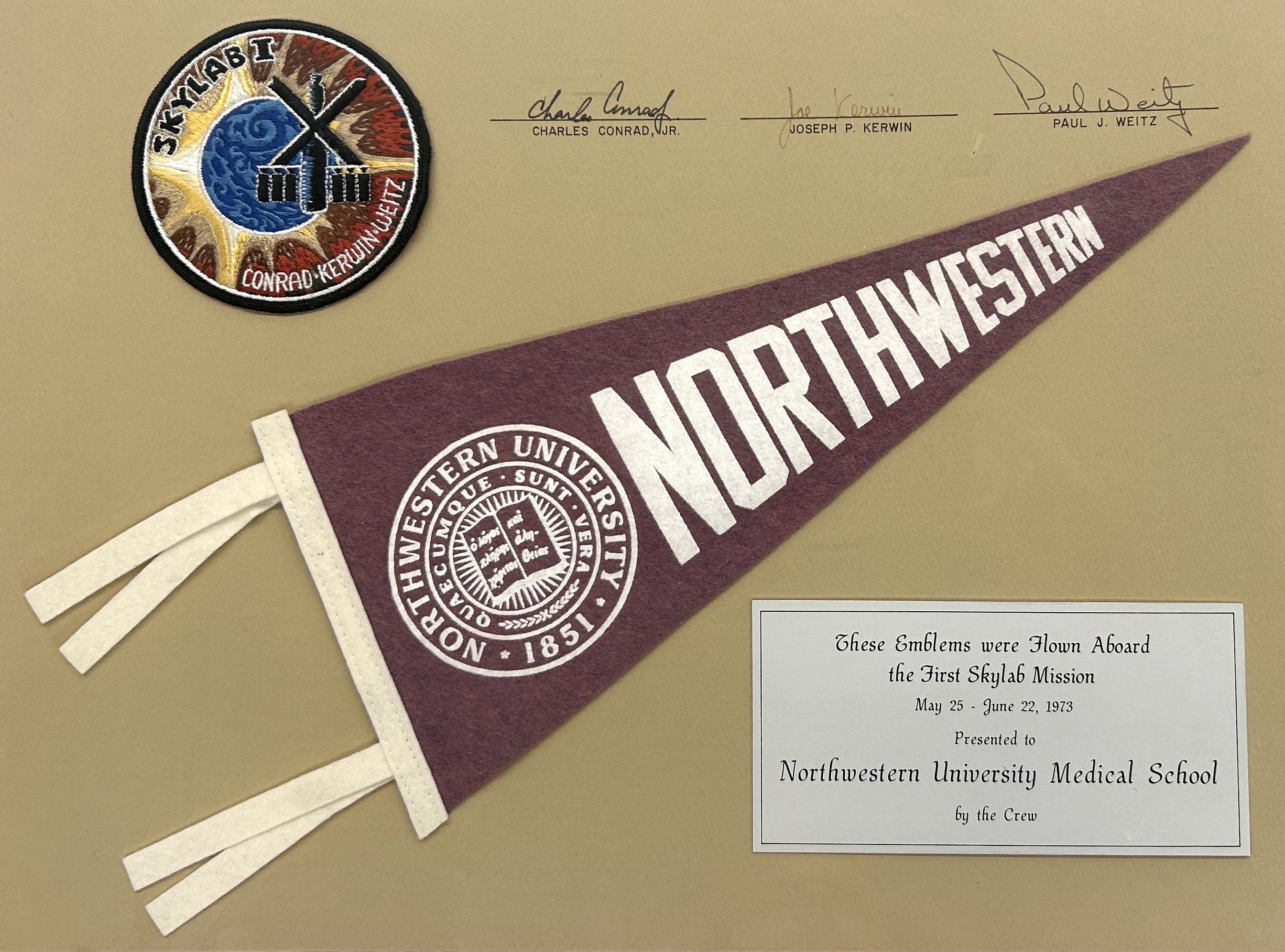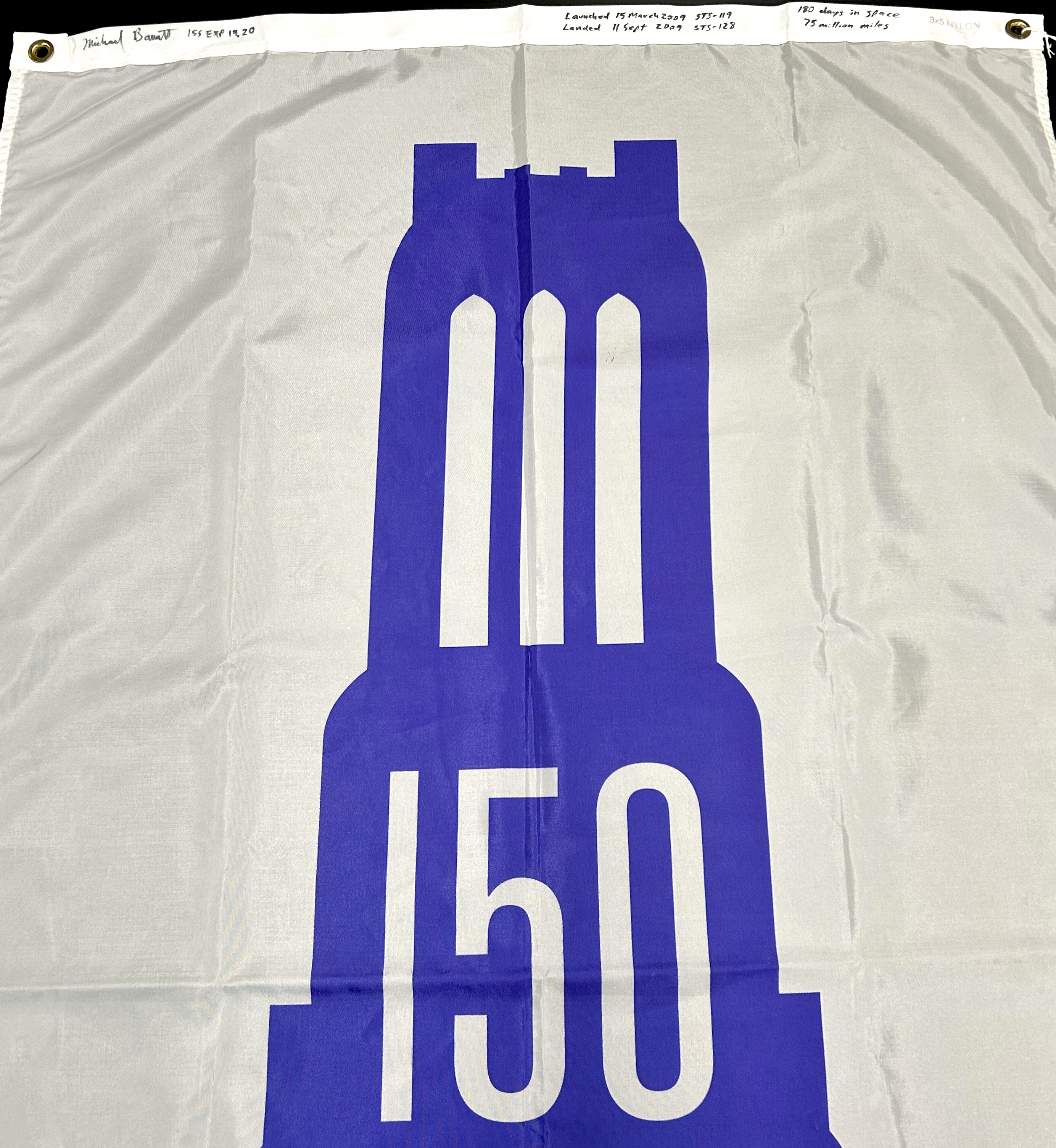Joseph Kerwin, MD, and Michael Barratt, MD
By Emma Florio, Archives & Research Specialist
Of the 360 men and women who have been selected as NASA astronauts since 1959, three have connections to the Feinberg School of Medicine: alumni Joseph Kerwin, MD, and Michael Barratt, MD, and former faculty member Robert Satcher, PhD, MD (featured in this article from 2025). This article covers the remarkable lives and careers of Feinberg’s astronaut alumni.
 |
|
1971 NASA portrait of Kerwin with a model of Skylab.
|
Joseph P. Kerwin was born on February 19, 1932, in Oak Park, Illinois. As a child he enjoyed reading science-fiction, although thoughts of traveling to space were strictly fantasy. In 1953 he earned a BA in philosophy with a pre-med minor from College of the Holy Cross in Worcester, Massachusetts. Having enjoyed his pre-med course work, Kerwin enrolled at Northwestern University Medical School and earned his MD in 1957.
After finishing medical school, Kerwin was drafted into the United States Navy under a program called the “doctor’s draft,” which aimed to get more physicians into the military. He attended the School of Aviation Medicine at Pensacola, Florida, and was designated a flight surgeon, who serves as the primary care physician for naval personnel. In this role, he studied the physiological effects of acceleration on the body and was particularly interested in how flight affected pilots’ vision. In 1961, Kerwin entered a program in which flight surgeons were fully trained as pilots, to better understand the experience of flight.
With his pilot training complete, Kerwin began flying high performance aircraft, but he missed medicine; he felt that he wasn’t learning any new medical knowledge while he focused on aviation. Pursuing his interest in pilots’ vision changes, he applied and was accepted to an ophthalmology residency at Northwestern. Before he could begin the program, though, he learned that NASA was planning to hire physicians and scientists as astronauts (previous astronauts had been military test pilots). He applied to the program and was selected for NASA’s fourth group of astronauts in June 1965.
Kerwin began his career at NASA with projects related to space suits and environmental control systems, both of which drew on his medical training. In 1973, Kerwin completed his first and only space flight aboard Skylab, America's first orbital space station, becoming the first physician in space in the process. He and his two crewmates spent 28 days aboard Skylab – the longest time anyone had been in space up to that point. On the mission, Kerwin performed scientific and medical experiments to determine human adaptability to prolonged spaceflight. These experiments proved that humans could live and work in space for an extended period of time, paving the way for the International Space Station (ISS).
After his spaceflight, Kerwin directed various branches of NASA, including the Space and Life Sciences directorate, where he offered medical support to manned spacecraft programs and directed research and experimentation. In this role he oversaw the Space Shuttle program, including the Space Shuttle Challenger, which was destroyed in an explosion shortly after launch on January 28, 1986; as medical director, Kerwin was charged with preparing the report on the deaths of the crew.
Kerwin retired from the Navy and left NASA in 1987. He subsequently moved into the private sector, where he continued to support crewed spaceflight and help develop life support systems and procedures for what would eventually become the ISS. He also served on the Board of Directors of the National Space Biomedical Research Institute. At the time of publication in August 2024, Kerwin is 92 years old and resides in Texas.
 |
|
2010 NASA portrait of Barratt with a model of Space Shuttle Discovery.
|
Michael Barratt was born on April 16, 1959, in Vancouver, Washington. As a child, he enjoyed astronomy and built telescopes as a hobby. He was also interested in biology and earned a BS in zoology from the University of Washington in 1981. He earned an MD from Northwestern University Medical School in 1985 and subsequently completed a residency in internal medicine at Northwestern. Combining his interests in astronomy and biology, Barratt completed a second residency and MS in aerospace medicine at Wright State University in 1991. Michelle Barratt, Michael's wife, also earned her MD in 1985 from NUMS and then completed a pediatrics residency at Lurie Children's Hospital (then called Children's Memorial Hospital). She is a pediatrician at UTHealth Houston and is a Professor of Pediatrics at the McGovern Medical School.
Throughout the 1990s, Barratt worked at NASA in various positions supporting medical systems, research, and training. In 1994, he was assigned to the joint US-Russian Shuttle/Mir program. In this role, he helped develop an onboard medical kit and trained the crew of the first Space Shuttle to dock with the Russian space station Mir. From 1995 to 1998, he acted as the lead physician for the first crew of the newly launched International Space Station.
As he was becoming one of the world’s experts in space medicine, Barratt felt that he would better understand the field if he experienced spaceflight himself. To that end, he applied to be an astronaut and was selected for NASA’s Astronaut Group 18 in 2000. In 2009 he spent 199 days aboard the ISS, where he performed two spacewalks, helped with station construction, and conducted onboard scientific and medical experiments. He completed his second mission in 2011, on the final 13-day flight of the Space Shuttle Discovery, which delivered modules to the ISS.
While training to be an astronaut and completing two missions, Barratt continued his work as a leader in space medicine. He was senior editor of the textbook Principles of Clinical Medicine for Space Flight, which was published in 2009 and is considered the authoritative reference on the subject. In 2010 he was the first recipient of the Aerospace Medical Association’s Joseph P. Kerwin Award for Advancements in Space Medicine, named for his fellow NUMS astronaut alumnus. Since that time, he has also served as Associate Editor for Space Medicine for the journal Aerospace Medicine and Human Performance.
In August 2023, Barratt was designated the Pilot of NASA’s SpaceX Crew-8 mission, which flew to the International Space Station on March 4, 2024. As with other ISS missions, the crew has performed maintenance on the ISS and conducted scientific and medical experiments. At the time of publication in August 2024, Barratt is currently aboard the International Space Station as part of Expedition 71. He has spent over 380 days in space over his three missions.
In the library


Both Kerwin and Barratt have taken Northwestern-related items into space - Kerwin aboard Skylab in 1973 and Barratt aboard the International Space Station in 2009 - and donated them to the library. Visit Galter Special Collections to view them in person.
Selected References
“Astronaut Biography: Michael R. Barratt.” National Aeronautics and Space Administration. Johnson Space Center. September 2023.
“Biographical Data: Joseph P. Kerwin.” National Aeronautics and Space Administration. Johnson Space Center. February 2002.
Kerwin, Joseph P. NASA Oral History Project. By Kevin M. Rusnak. National Aeronautics and Space Administration, Johnson Space Center, May 12, 2000.
Malik, Tariq. “Star Trek: The Real Doctor McCoy.” Space.com. May 5, 2009.
Updated: February 12, 2025